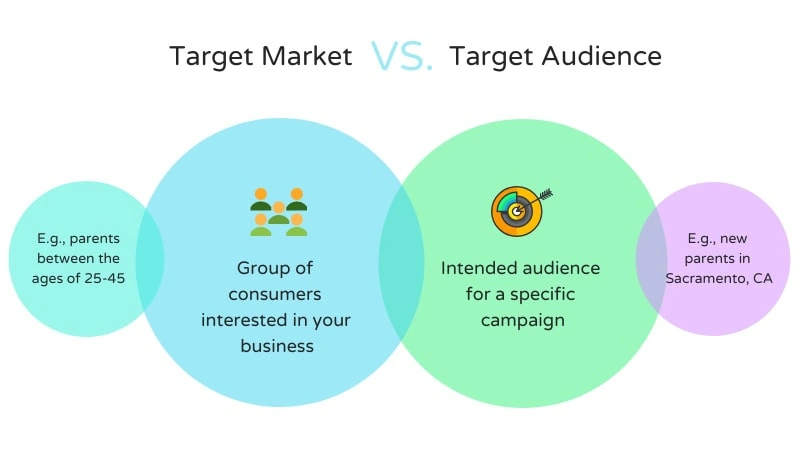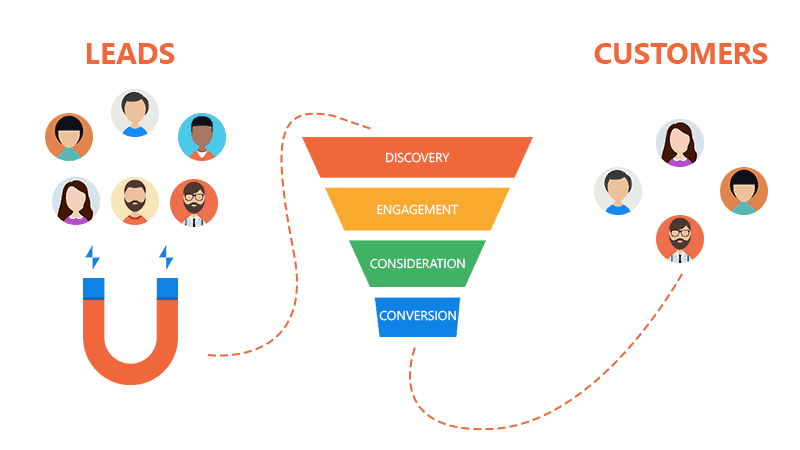How to Increase Engagement and Lead Conversions
Capturing and retaining the attention of your target audience is more challenging than ever. With endless content and distraction just a click away, simply getting viewers to your website is no longer enough.
You must actively engage and persuade them to take the desired action, whether signing up for your newsletter, requesting a demo, or purchasing.
In this post, I'll provide actionable tips to increase engagement and boost lead conversions on your website or landing pages. With the right mix of content, web design, calls-to-action, and follow-up, you can connect with visitors and inspire them to convert at higher rates.
Creating compelling content is the first step to sparking interest and driving engagement. Ensure your copy speaks directly to your ideal customer and focuses on solving their pain points. Use visual elements like images, videos, and graphics to capture attention in a sea of text-heavy sites.
Next, your website itself needs to be optimised for engagement. Pay attention to page load speeds, layout, calls-to-action and forms. Remove distractions and friction points that can cause visitors to click away impatiently.
Consider embedding a sales lead form directly on your high-traffic pages. A streamlined form asking only for essential information—such as name and email—can drastically reduce friction and capture qualified prospects before they exit.
- Create compelling content that addresses customer pain points to enhance engagement and lead conversions.
- Optimise websites for mobile-first experiences to cater to the growing mobile user base.
- Utilise clear calls-to-action and personalised emails to guide visitors towards conversion.
- Continuously analyse engagement metrics to refine strategies and improve conversion rates.
- The Mobile-First Engagement Approach
- Understanding the Importance of Engagement and Lead Conversions
- Identifying Target Audience
- Creating Engaging Content
- Voice Search Optimisation for Engagement
- Utilising Social Media Platforms
- Implementing Email Marketing Strategies
- Utilising Lead Generation Techniques
- Visual Search and Image Optimisation
- Analysing and Tracking Engagement and Conversions
- Conclusion
- Frequently Asked Questions
The Mobile-First Engagement Approach

With about 60% of web traffic now coming from mobile devices, your engagement strategy simply can't succeed without a mobile-first mindset. Gone are the days when mobile was an afterthought.
Your visitors expect seamless experiences regardless of screen size. If your site isn't mobile-friendly, you're likely losing over half your potential conversions before they even start.
Speed matters tremendously on mobile. Research from Google shows that 53% of mobile users abandon sites that take longer than three seconds to load. That's a massive chunk of potential leads gone because of a few seconds delay.
Mobile users tend to be more impatient and goal-oriented. They want to find information or complete tasks quickly without pinching, zooming, or struggling with tiny buttons.
Make your forms mobile-friendly by keeping them short and using appropriate input types. No one wants to fill out twenty fields on a tiny screen, and auto-detecting phone number formats saves frustration.
Touch targets need to be large enough for thumbs, not mouse pointers. Buttons should be at least 44×44 pixels with adequate spacing between clickable elements to prevent accidental taps.
If you have checkout processes, simplify them for mobile. Each additional step loses approximately 10% of potential conversions. Consider offering mobile payment options like Apple Pay or Google Pay for one-tap purchasing.
Test your site on actual mobile devices, not just browser simulators. Real-world usage patterns often reveal issues that development environments miss.
It's also essential to guide your visitors with clear calls to action for conversions. Use action-driven language, strategic placement and contrasting colours to direct them to signup forms, demos, free trials or purchases.
Finally, pay attention to follow-up and retention. Continue nurturing relationships via email, social media, and remarketing campaigns—the more touchpoints there are, the higher the chance of converting subscribers into customers.
Follow these tips to boost engagement metrics and lead conversion rates quickly. Let's dive in!
Understanding the Importance of Engagement and Lead Conversions

A deep understanding of engagement and lead conversions is critical for businesses keen on success in the current competitive market.
It involves forming connections with potential customers, cultivating relationships, and eventually converting them into loyal clients. The significance of these two elements must be considered as they directly influence a company's growth and profitability.
Fathoming high levels of engagement necessitates creative marketing techniques tailored to captivate your target audience. This can be done through gripping storytelling, interactive content, and personalisation.
Proficient lead conversions rely on efficient communication throughout sales while pinpointing customer pain points and proffering solutions.
Companies can foster significant ties with their audience that bring long-term success by grasping the importance of engagement and lead conversions.
Did you know that companies with potent engagement strategies enjoy 33% higher annual revenue growth than those without? (source: Aberdeen Group)
Recent data paints an interesting picture of current engagement patterns. The average website session duration across industries sits at just 2-3 minutes according to Contentsquare's 2023 Digital Experience Benchmark report.
Conversion rates vary significantly by industry, with e-commerce sites averaging 2.5-3% while B2B websites typically achieve around 2.23%. These benchmarks help set realistic targets for your campaigns.
Personalisation continues to prove its worth, with McKinsey research showing that tailored experiences can boost conversion rates by 10-15%. This applies across channels from email to on-site content.
The first five seconds of page visits are decisive. Users form initial impressions almost instantly, and most decide whether to stay or leave within this brief window.
Identifying Target Audience

Defining your ideal customer profile is crucial to identifying your target audience effectively. By understanding your target customers' characteristics, preferences, and needs, you can tailor your marketing strategies and content to resonate with them.
This subsection will define your ideal customer profile and its importance in increasing engagement and lead conversions.
Defining Ideal Customer Profile
Defining the Ideal Customer Profile is essential to target the right audience. Knowing their specific characteristics and preferences helps create successful marketing strategies. Let's look at the details further.
The table below shows the components of an ideal customer profile:
| Category | Description |
| Demographics | Age, Gender, Location |
| Psychographics | Interests, Values, Lifestyle |
| Buying Behaviour | Purchase frequency, Budget |
| Pain Points | Challenges and frustrations |
| Communication Preferences | Preferred channels |
Consider unique cultural background, technological literacy, or environmental concerns. This will help tailor your marketing better.
To define an ideal customer profile, try the following:
- Do Market Research: Collect data through surveys, interviews, and market analysis to understand your target audience's needs.
- Analyse Existing Customer Data: Check your current customers to identify patterns that align with your target market.
- Segment Your Audience: Group customers based on common characteristics or buying behaviours. This helps you tailor messages for each group.
- Test and Refine Marketing Strategies: Test various marketing strategies targeted towards this audience segment. Monitor how well they resonate with this group.
By following these steps, businesses can understand their target audience and ensure practical marketing efforts. Remember that defining the ideal customer profile is a continuous process that should be periodically revisited and refined.
Creating Engaging Content

Increase engagement and lead conversions by creating engaging content, using captivating headlines, incorporating visuals and multimedia, and crafting compelling calls to action.
These techniques will grab your readers' attention and make your content more visually appealing and persuasive, ultimately driving higher engagement and conversions.
Using Captivating Headlines
Headlines must be precise and short. This allows readers to comprehend what they can anticipate from the article.
Using impressive and descriptive words in headlines can evoke emotion and interest in readers, urging them to click and explore further.
Numbers and data in headlines create a definite sense and inform readers of what they will gain from reading the content.
Furthermore, by using keywords related to the central theme of the content, SEO is improved, and organic traffic to the article is increased. Including captivating headlines improves the chances of engaging readers and amplifying the impact of the content.
History has it that newspaper editors knew the need for captivating headlines.
Newspapers used phrases that spark curiosity to sell more copies and draw readers. This concept has shifted over the years with online media, so making striking headlines is still essential for digital publishers.
Incorporating Visuals and Multimedia
Using visuals and multimedia is essential for creating engaging content that captures and keeps the audience's attention. Images, videos, infographics, and animations improve the look and help communicate facts well.
Utilising various multimedia formats can make the content more interactive and attractive.
Adding a custom QR code can also allow viewers to access additional information or special features and enhance their overall experience with interactive content.
Look at the table below to see the influence of including visuals and multimedia in content creation:
| Visuals/Multimedia Content | Benefits |
| Images | Enhances understanding |
| Videos | Grabs viewers |
| Infographics | It makes complex info simple |
| Animations | It makes concepts come alive |
Moreover, strategically using relevant visuals and multimedia throughout the content can divide long blocks of text and give visual breaks for better legibility. This helps keep readers interested and makes sure they stay engaged.
Pro Tip: When using visuals, be sure they are of high quality, relevant to the topic, and back up the whole message of the content. Consider optimising them for different devices to give an uninterrupted user experience.
Crafting Compelling Call-to-Actions
When crafting call-to-actions, it's essential to stay away from generic phrases. Tailor them to your target audience and their needs. Understand their pain points and desires for effective results.
Call-to-actions date back centuries. In the early days of print advertising, businesses used taglines and slogans to urge customers to take action. An example is De Beers' “A Diamond is Forever” slogan. It captured people's attention and made diamonds a symbol of eternal love.
To create a compelling CTA, employ persuasive language. Highlight benefits and understand your audience. This will drive engagement and achieve desired outcomes.
Make it urgent with time-sensitive language like “limited time offer” or “offer ends soon”. Use persuasive words like “exclusive” or “one-time opportunity” to make readers feel special. Include clear instructions on what you want them to do. Highlight the benefits and value of taking action.
Utilise emotional triggers to evoke solid responses and increase engagement. Experiment with catchy headlines, visuals, and interactive elements to capture attention.
Voice Search Optimisation for Engagement

Voice search has rapidly evolved from novelty to necessity. Approximately 41% of adults use voice search daily according to Pwc research, and this number continues to climb.
Smart speakers now inhabit over 35% of US households, with similar adoption rates growing across the UK and Europe. This shift changes how people find and interact with content.
Voice queries differ significantly from typed searches. They tend to be longer, more conversational, and often phrased as questions. “Best Italian restaurant London” becomes “What's the best Italian restaurant near me in Central London?”
To optimise for voice search engagement, structure content to answer specific questions. FAQ sections work particularly well for voice search results.
Focus on long-tail, conversational keywords that match natural speech patterns. Think about how people actually talk, not how they type.
Local businesses should pay special attention, as “near me” voice searches have grown 900% in recent years. Ensure your Google Business Profile is complete with accurate information.
Voice search users often seek quick, direct answers. Featured snippets (position zero in search results) are frequently what voice assistants read aloud. Structure content with clear headings and concise answers to improve chances of securing these positions.
Mobile optimisation and page speed are even more important for voice search success, as most voice searches happen on mobile devices. If your site loads slowly or displays poorly on mobile, voice searchers will never see it.
Utilising Social Media Platforms

Utilise social media platforms to increase engagement and lead conversions. Build a strong presence on Facebook, leverage Instagram for increased engagement, and engage with your audience on X. Each sub-section will offer valuable insights into leveraging these platforms effectively for better engagement and conversions.
Building a Strong Presence on Facebook
If you're a business or individual wanting to make waves on Facebook, having a strong presence is essential. This can give you more visibility and help you engage with a larger group of people. Here are three key points to keep in mind:
Make sure your posts are informative, fun, and eye-catching. Use images and videos to draw attention.
Answer comments and messages quickly and encourage discussion. This helps create a loyal fan base that feels appreciated.
Take advantage of their analytics tool to gain insights into engagement rates, demographics, and ad performance. This data can help guide your content strategy.
- Create compelling content:
- Engage with your audience:
- Utilise Facebook Analytics:
Moreover, remember to use Facebook's advertising features to expand your reach even further. As of 2023, over 3.03 billion active monthly users (Source: DemandSage). This offers massive opportunities to businesses and individuals looking to make an impact online.
Leveraging Instagram for Increased Engagement
Instagram is a hugely popular social media platform, so leverage it for maximum engagement. Here's how:
- Optimise your profile with relevant brand or business information to attract followers.
- Post high-quality content – share visuals that fit your audience's interests.
- Include relevant hashtags – use popular and niche-specific tags to increase your reach.
- Engage with your audience – promptly reply to comments, messages, and mentions. Like posts, and follow back when appropriate.
- To encourage interaction, use Instagram Stories to share behind-the-scenes content, limited-time offers, or polls.
- Collaborate with influencers, run contests, and track analytics to measure success.
- Geotag posts to enhance discoverability – add a location to attract local followers.
Engaging with the Audience on X
For businesses, engaging with their audience on X (Twitter) is a must for building a robust online presence. Respond quickly to their posts and show interest in their feedback. Have conversations and encourage user-generated content to create a community.
Strike the right balance when engaging with your audience. Don't bombard them with self-promotion. Instead, give them valuable content to start meaningful conversations. Retweet relevant posts, share news, and be part of trending topics to show your expertise and get new followers.
In addition, use X's features like polls, quizzes, and live chats. These interactive tools engage followers and attract new ones: post images, videos, and GIFS to make your tweets stand out and be shareable.
Engaging with your audience on X means more than posting updates. Interact, be responsive to feedback, and create a community. Utilise the platform's features to offer valuable content, and you'll have a loyal following advocating for you.
Implementing Email Marketing Strategies

To increase engagement and lead conversions with email marketing strategies, you must master the art of building an email list, segmenting for personalisation, and creating effective email campaigns.
These sub-sections are essential in optimising your email marketing efforts and effectively reaching your target audience.
Building an Email List
Generate leads by creating content and offers to persuade visitors to give you their email addresses. Try out various placements of opt-in forms, such as the sidebar, pop-ups, or blog posts.
Segment your subscribers based on their characteristics, interests, or habits. This allows you to send emails that are tailored to specific audiences.
Ensure list accuracy by frequently deleting inactive or bounced emails. It keeps your list fresh and maintains a good sender reputation.
Make sure to obey data protection regulations such as GDPR. Get permission from people before adding them to your list and provide options to opt out.
Segmenting the Email List for Personalisation
Segmenting the email list leads to personalisation. This results in more engagement and conversions.
Grouping recipients according to their demographics, behaviour, or past purchases allows for tailored emails that meet their needs and interests.
For example:
| Segment | Demographics | Behaviour | Past Purchases |
| Segment 1 | Age: 18-25 | Opened last email | None |
| Segment 2 | Age: 26-35 | Clicked on a link | Product A |
| Segment 3 | Age: 36-45 | Made a purchase | Product B |
Categorising subscribers into different segments helps businesses craft tailored emails.
Segment 1 may get emails with new products suitable for their age group. Segment 2 may get follow-up emails featuring products they clicked on before. Lastly, Segment 3 may get personalised recommendations based on their past purchases.
To further personalise:
- Use dynamic content: Insert personal elements like the recipient's name or location.
- Conduct surveys: Gather preferences and interests from subscribers to deliver more appropriate content.
- Implement triggered emails: Set up automated emails triggered by specific actions (e.g., abandoned carts) to re-engage customers with personalised offers.
AI tools have transformed what's possible with email personalisation. Businesses using AI-driven personalisation report email open rates jumping by up to 41% according to Campaign Monitor data.
Predictive analytics can now anticipate customer behaviour, allowing you to send the right message before customers even know they want it. These systems analyse past interactions to forecast future needs.
Subject line optimisation tools use machine learning to test thousands of variations and determine which phrases resonate best with specific audience segments. This removes guesswork from one of email's most important elements.
Send-time optimisation calculates when each individual subscriber is most likely to open emails based on their past behaviour. This ensures your message arrives when recipients are actively checking their inbox.
The ROI of implementing AI personalisation is quite strong. Salesforce research indicates businesses using these technologies experience 20% higher engagement rates on average, translating directly to improved conversion metrics.
These ideas recognise each subscriber's uniqueness. Catering to individual preferences and behaviours strengthens relationships with subscribers and increases the chance of conversion.
Creating Effective Email Campaigns
Executing email campaigns well is essential for businesses to hit their marketing goals. Consider these 4 points:
- Personalise: Make your emails unique to make readers feel valued. Address them by name and provide content they'll enjoy.
- Catchy Subject Lines: Ensure your subject lines draw readers in and encourage them to open your emails.
- Engaging Content: Write content that grabs people's attention right away. Use fascinating language and visuals with clear calls to action.
- Mobile Optimisation: Make sure your emails look good on mobile devices, as many people use them to check emails.
Monitor key metrics like open and click-through rates to tweak your strategies. Powerful campaigns can get customers, conversions and money for your business. Write content based on data and what your subscribers need. Start using these tactics today!
Utilising Lead Generation Techniques
To increase engagement and lead conversions, utilise lead generation techniques.
Create and promote lead magnets, optimise landing pages for lead captures, and implement A/B testing for lead conversion optimisation. Each sub-section offers a solution to enhance your results.
Creating and Promoting Lead Magnets
Lead magnets are essential for creating leads for your business. Here's a step-by-step guide to help you make and promote them:
- Identify your audience. Understand their needs and preferences to make a lead magnet that will attract them.
- Choose the correct format. Consider formats like ebooks, templates, checklists, or webinars to create resonating content.
- Provide value. Offer unique insights, tips, or solutions to a specific problem.
- Design a remarkable landing page. Make a visually appealing page that communicates the benefits and encourages visitors to provide their information.
- Optimise for conversion. Use persuasive copywriting with headlines and CTA to increase conversions.
- Promote everywhere. Share across social media, email marketing, guest blogging, and influencer collaborations.
Track the performance of your lead magnet by monitoring metrics like click-through and conversion rates. Make changes for better results.
One of our clients used a quiz as their lead magnet strategy. By asking intriguing questions and giving personalised insights, they saw an increase in lead generation. This creative approach engaged their target audience and established them as experts in their field.
Creating and promoting lead magnets takes careful planning, understanding your audience, and optimisation based on data insights. Use these strategies wisely for high-quality leads.
Optimising Landing Pages for Lead Captures
Landing pages are a must for capturing leads and converting people into customers. Here's what to keep in mind to optimise them:
- Design a visually attractive and professional look that matches your brand. Use high-quality pictures and short, precise writing to interest visitors.
- The form on the page should be short and easy. Asking for too much can put off potential leads.
- Make the call-to-action (CTA) button stand out. Use bright colours, persuasive text, and intelligent placement to attract attention.
- Test elements like headlines, images, forms and CTAS using A/B testing. This helps you see what works best for your audience.
- Speed up the loading of your page. Slow pages can lead to high bounce rates and reduce lead generation.
- Add social proof elements such as testimonials or case studies to make visitors trust you.
Add a live chat feature for better lead capture through landing page optimisation. This helps visitors talk in real-time with your team and clear doubts before becoming leads.
Pro Tip: Pay attention to mobile optimisation. With more users accessing websites through phones, ensure your landing pages are fully responsive across all screen sizes.
By optimising your landing pages for lead capture, you can get more potential customers and drive conversions. Keep these strategies in mind to get successful lead campaigns.
Implementing A/B Testing for Lead Conversion Optimisation

Look here! This table has the results of an A/B test on a landing page.
| Variation | Visitors | Conversions | Conversion Rate |
| A | 1000 | 50 | 5% |
| B | 1000 | 70 | 7% |
So, the conversion rate of Variation B was higher – 7%!
A/B testing helps businesses make data-driven decisions to optimise lead conversions and better marketing. It's unique: A/B testing helps refine strategies based on evidence-backed results. This continual improvement boosts lead conversion and customer acquisition.
Pro Tip: When doing A/B tests, just test one element simultaneously. Pushing multiple changes simultaneously can mess up the analysis and block accurate optimisation.
Visual Search and Image Optimisation

Visual search technology has quietly revolutionised how people find products and content online. Rather than typing text queries, users can simply upload an image or point their camera at an object to find similar items.
This shift represents a massive opportunity for businesses. Research from ViSenze found that 62% of millennials prefer visual search over traditional text-based methods.
Platforms like Pinterest Lens, Google Lens, and even Bing Visual Search process billions of visual queries monthly. These tools allow users to shop for what they see in the real world or in images they encounter online.
For businesses seeking to capitalise on visual search, proper image optimisation becomes non-negotiable. High-quality, clear product images from multiple angles increase discoverability.
Alt text serves double duty for accessibility and search visibility. Descriptive alt text helps visually impaired users while providing context for search engines to understand image content.
Implement structured data markup (schema.org) for images to provide search engines with explicit information about what your images contain. This significantly improves the chances of appearing in visual search results.
File names matter more than most realise. Change generic “Img12345.jpg” to descriptive “red-leather-crossbody-bag.jpg” to give search engines additional context clues.
Compression techniques that reduce file size without sacrificing quality ensure faster loading times. Remember that slow-loading images frustrate users and harm engagement metrics.
Visual search converts at higher rates than text search for certain product categories. Fashion retailers report conversion rates up to 50% higher from visual search traffic compared to text search visitors.
Analysing and Tracking Engagement and Conversions

To increase engagement and lead conversions by analysing and tracking, utilise analytics tools and monitor metrics alongside crucial performance indicators. By doing so, you can gain valuable insights and make data-driven decisions.
Utilising Analytics Tools
| Metric | Description |
| Website Traffic | The number of visitors to the website within a specific timeframe |
| Bounce Rate | The percentage of visitors who leave the website after viewing only one page |
| Time Spent on Site | The average duration of time visitors spend on the website |
| Conversion Rates | The percentage of visitors who complete a desired action, such as making a purchase or filling out a form |
| Click-Through Rates (CTR) | The percentage of users who click on a specific link or advertisement |
| Cost-Per-Action (CPA) | The amount it costs to acquire a customer or complete a particular action |
| Return on Investment (ROI) | The measure of the profitability of an investment, calculated by dividing the gain or loss by the cost |
Businesses must measure key performance indicators (KPIs) specific to their objectives. These KPIS could include click-through rates, cost-per-action, or return on investment (ROI).
Regularly review analytics data. This allows businesses to identify areas of improvement and potential growth opportunities. Analysing data from different tools helps refine strategies to maximise engagement and conversions.
Monitoring Metrics and Key Performance Indicators
Take a peek at the table below to see some key metrics and KPIS:
| Metric | Description |
| Conversion Rate | % of website/landing page visitors who take desired actions. |
| Click-Through Rate | % of people who click on a specific link, ad or CTA. |
| Bounce Rate | % of visitors who leave after viewing only one page. |
| Average Session Duration | Average amount of time users spend on a website in one session. |
| Customer Lifetime Value | Predicted net profit from the whole future relationship with a customer. |
Analytical tools such as Google Analytics can track these metrics, allowing businesses to measure their digital performance accurately.
By monitoring these metrics often, companies can spot strengths and weaknesses in their campaigns and make changes to boost engagement and conversions. Other factors such as social media reach, email open rates, and ROI also come into play when evaluating marketing success.
An example of the importance of tracking metrics and KPIS is Facebook's News Feed algorithm update in 2018. This update prioritised content from friends & family instead of branded posts. As a result, companies counting on Facebook for organic reach witnessed a considerable decrease in visibility.
Due to this change, many businesses had to change their social media strategies. They needed to focus more on paid ads or diversify their channels to stay in touch with their target audience.
Conclusion
In conclusion, businesses can succeed with increased engagement and lead conversions.
Strategies and techniques should be used to make meaningful connections and capture target audiences. Personalising the messaging to customers is also essential, as their needs and interests should be considered.
Using social media platforms can be beneficial. There are billions of active users, so it can draw attention and encourage actions. Content should be visually appealing to capture and maintain user interest.
For example, A small online boutique had declining conversion rates but a solid social media presence. The messaging was too generic and didn't connect with the target audience.
To fix this, they segmented their email list and sent personalised emails. These included product recommendations, discounts, and content. This raised their conversion rates by 50% in three months.
Frequently Asked Questions
How can I increase engagement on my website?
Increasing engagement on your website can be achieved through various strategies. Some effective methods include creating compelling and valuable content, utilising interactive features such as quizzes or polls, improving website speed and navigation, and encouraging social sharing and commenting.
What are some ways to improve lead conversions?
Optimise your landing pages with clear, concise messaging, compelling call-to-actions, and user-friendly forms to improve lead conversions. Effective lead-nurturing techniques, such as personalised email campaigns and targeted remarketing ads, can significantly increase conversions.
Should I use social media to increase engagement and lead conversions?
Leveraging social media platforms can significantly increase engagement and lead to conversions. Create engaging and shareable social media content, actively respond to comments and messages, and use paid advertising options to reach a wider audience.
How important is website design in increasing engagement and lead conversions?
Website design is crucial in increasing engagement and lead conversions. A visually appealing and user-friendly website design helps to establish trust, improve user experience, and encourages visitors to take action. Invest in a responsive design, straightforward navigation, and compelling visuals to enhance engagement and conversions.
Are there any tools or software that can help increase engagement and lead conversions?
Several tools and software are available to increase engagement and lead conversions. Some popular options include content management systems like WordPress, email marketing platforms like MailChimp, customer relationship management (CRM) software like HubSpot, and analytics tools like Google Analytics.
Is it necessary to regularly analyse and measure engagement and conversion metrics?
Absolutely. Regularly analysing and measuring engagement and conversion metrics is essential to identify what strategies are working and where improvements are needed. Use tools like Google Analytics to track website traffic, engagement, and conversion rates. This data will help you optimise your efforts and achieve better results.

